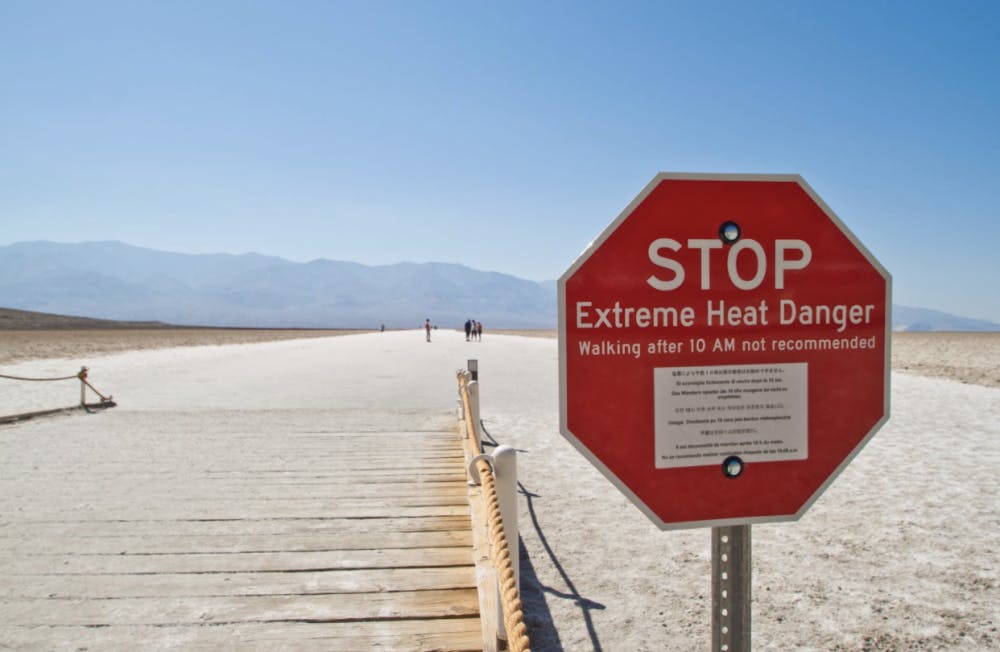The impacts of increasing heat waves are more than skin deep.
BY: CHELSEA WORRELL
As winter ushers in the first snowfall to Miami University, I find myself reminiscing on the hotter days of summer and fall. In freezing temperatures, nothing sounds more enticing than a warm, sunny day. But cooling temperatures provide only temporary relief from the increasing heat waves brought on by global warming. When we recall warmer days, we must not forget the sweltering ones.
Ohio currently experiences around five days of extreme heat per year. In just nine short years, that number is projected to double to ten. According to this projection, temperatures will reach a heat index of over 105 degrees Fahrenheit on ten days of the year.1 As Paris Hilton once said, “That’s hot.”
One of the most alarming aspects of this projection is its implication for human health. At high outdoor temperatures, our body’s capacity to regulate its internal temperature is exceeded. Without regulation, the body succumbs to a potentially life-threatening condition termed “heat stress”. 2
Heat stress produces acute physical symptoms ranging from muscle spasms to increased heart rate. With excessive exposure to heat, dangerous neurological deficits begin to present themselves. Heat impairs our brain’s ability to make decisions and limits our capacity for attention.2 This could be the difference between life and death for individuals with careers that require rapid decision-making and clear focus, such as first responders and military personnel. Mental deficits could also render seemingly harmless activities such as driving a car into a potential fatality. Heat stress compromises not only our ability to maintain our own safety, but the safety of others as well.
Although heat stress was previously thought to occur only in extreme temperatures, recent evidence suggests otherwise. Short term heat stress can produce memory disruptions at just 82 degrees Fahrenheit when humidity is at 97%.3 Meanwhile, long term exposure to heat stress can produce developmental effects along with a plethora of other declines. For example, extended heat exposure can decrease one’s ability to control reward behavior.2 Dysfunction in reward behavior underlies disorders such as schizophrenia, major depressive disorder4 and substance use disorders.5 The neurological impacts of heat stress may be more widespread than we previously imagined.
Protecting our brains from hotter temperatures will require a collaborative and concerted global effort. In Australia, heat stress is the deadliest natural hazard, killing more people per year than all natural hazards combined. This is just one horrific consequence of a warming climate combined with a lack of firm action. Our survival will require planned adaptation and governmental intervention. Policies must account for populations at-risk for heat stress such as the homeless, chronically ill persons, children, and the elderly.6
Moreover, we need to shift our attention from treatment to prevention. Heat stress already affects around 500 million people. If temperatures continue to rise at the current rate, 1.2 billion people will experience heat stress in just 80 years.7 At this temperature, severe mental declines will prevent us from making appropriate survival decisions. Although this projection may frighten us, perhaps it can galvanize us. With immediate action, we might just be able to beat the heat.
My growing awareness of the tight-knit relationship between environmental and neurological health has incited me to pursue a master’s degree in environmental health sciences. This career will allow me to integrate my passion for neuroscience with my concern for the planet’s wellbeing. I encourage any student with environmental concerns to search for a relationship between your area of study and environmental science. As a senior psychology and premedical student who now finds herself writing for GreenHawks, I implore you to try something new!
1 States At Risk. (2015). https://statesatrisk.org/ohio/extreme-heat
2 Soravia, C, Ashton, B.J., Thornton, A., Ridley, A.R. (2021), The impacts of heat stress on animal cognition: Implications for adaptation to a changing climate. WIREs Clim Change. 12: e713. https://doi.org/10.1002/wcc.713
Enjoy what you're reading?
Signup for our newsletter
3 Inan, S. Y., & Aksu, F. (2002). Amnesic effects of relative humidity and temperature in mice. Lab Animal, 31, 40–48
4 Whitton, A. E., Treadway, M. T., & Pizzagalli, D. A. (2015). Reward processing dysfunction in major depression, bipolar disorder and schizophrenia. Current opinion in psychiatry, 28(1), 7–12. https://doi.org/10.1097/YCO.0000000000000122
5 Izquierdo, A., & Jentsch, J. D. (2012). Reversal learning as a measure of impulsive and compulsive behavior in addictions. Psychopharmacology, 219(2), 607–620. https://doi.org/10.1007/s00213-011-2579-7
6 Oppermann, E., Brearley, M., Law, L., Smith, J.A., Clough, A. and Zander, K. (2017), Heat, health, and humidity in Australia's monsoon tropics: a critical review of the problematization of ‘heat’ in a changing climate. WIREs Clim Change, 8: e468. https://doi.org/10.1002/wcc.468
7 Rutgers University. (2020, March 12). Heat stress may affect more than 1.2 billion people annually by 2100: Rising global temperatures are increasing exposure to extreme heat and humidity. ScienceDaily. Retrieved November 14, 2021 from www.sciencedaily.com/releases/2020/03/200312142256.htm




